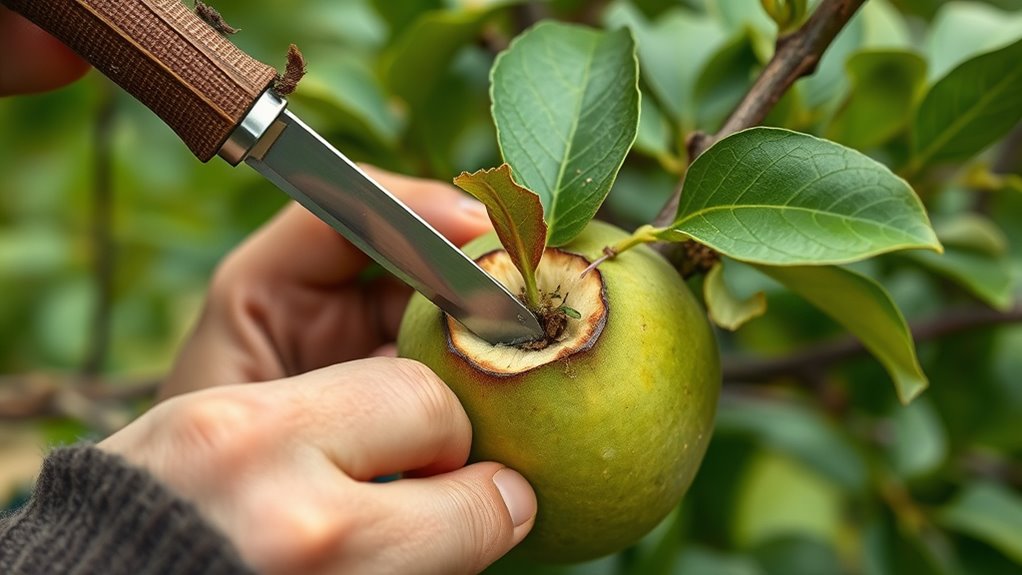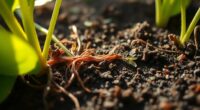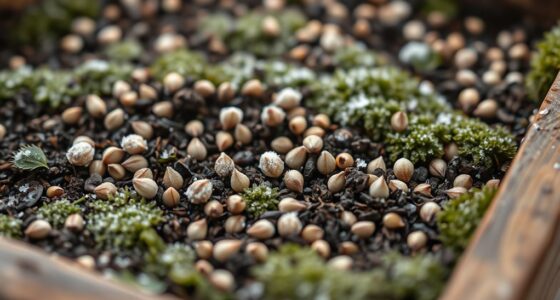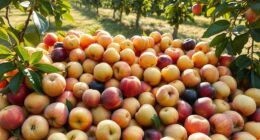Grafting fruit trees involves selecting the right rootstock and carefully attaching the scion to guarantee successful growth. Focus on making clean, matching cuts that align the cambial layers properly, as this is essential for tissue fusion. Keep the graft moist and secure it tightly to promote healing. Proper technique and attention to detail can considerably increase your success rate. If you keep exploring, you’ll discover even more tips to improve your grafting results.
Key Takeaways
- Select compatible rootstocks suited for your soil and climate to ensure healthy growth and desired tree size.
- Proper cambial alignment between scion and rootstock is essential for successful graft union.
- Use clean, sharp tools and precise cuts to facilitate tissue fusion and reduce infection risk.
- Secure the graft firmly with tape or grafting wax to maintain contact and promote healing.
- Maintain optimal moisture and environmental conditions to support graft take and healthy development.
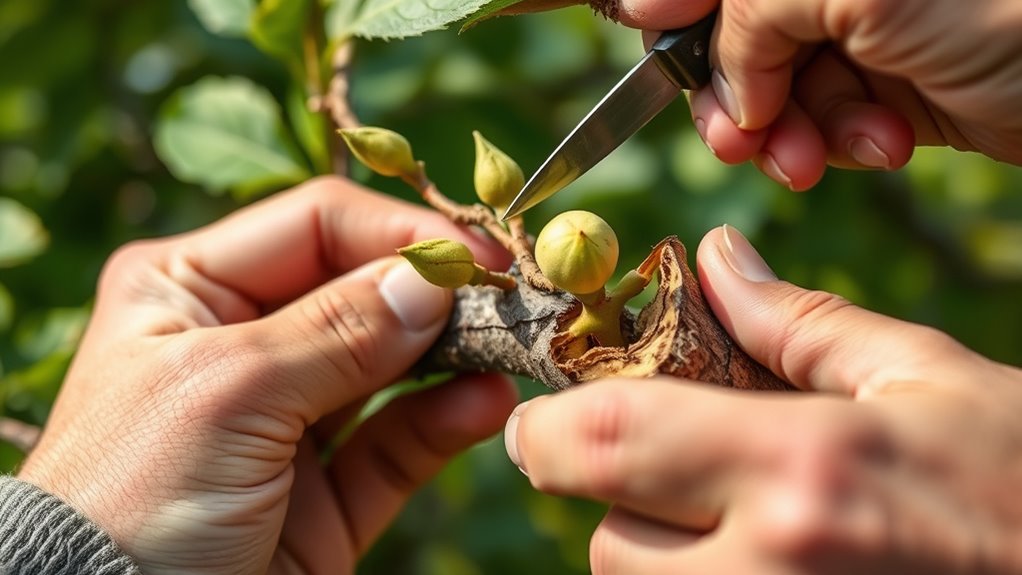
Grafting is a fundamental technique for propagating and improving fruit trees, and understanding its basics can help you produce healthier, more productive plants. One of the most critical aspects of successful grafting is selecting the right rootstock. Your choice of rootstock influences the tree’s overall health, size, disease resistance, and adaptability to soil and climate conditions. When selecting a rootstock, consider the mature size of the tree you want, as some rootstocks produce dwarf or semi-dwarf trees suitable for small spaces, while others yield full-sized trees. You also need to think about pest and disease resistance, soil compatibility, and the rootstock’s vigor. Picking the right rootstock ensures that your graft will thrive and that you’ll get the desired fruit quality and yield over time.
Equally important is guaranteeing proper cambial alignment during grafting. The cambium, a thin layer of actively dividing cells just beneath the bark, is the essential tissue that allows the scion and rootstock to fuse and grow together. When you make your cuts, it’s essential to match the cambial layers of both the rootstock and the scion precisely. Misalignment can prevent the tissues from connecting properly, leading to graft failure. To achieve proper cambial alignment, you should cut both the rootstock and the scion at matching angles, ensuring that the cambial layers are flush against each other. When the cambium layers are aligned correctly, the tissues can grow together seamlessly, forming a strong bond that sustains the flow of nutrients and water from roots to leaves. Additionally, maintaining optimal moisture levels around the graft site promotes successful healing and tissue fusion.
The process of grafting requires clean, sharp tools to make precise cuts, minimizing damage and promoting quick healing. Keep in mind that the success of your graft depends heavily on your attention to detail during these initial steps. After making your cuts and aligning the cambial layers, secure the graft tightly with grafting tape or a similar material to hold everything in place while healing occurs. Proper rootstock selection combined with meticulous cambial alignment creates the foundation for a successful graft. It’s the key to ensuring that the graft takes quickly and the new growth develops into a healthy, fruit-bearing tree.
Frequently Asked Questions
What Are the Common Mistakes to Avoid When Grafting Fruit Trees?
When grafting fruit trees, avoid common mistakes like rushing the process or using improper technique, which can lead to graft failure. Be cautious of graft incompatibility, especially with distant or unrelated varieties, as it can prevent successful union. Always guarantee the cambium layers align correctly and use clean tools. Taking your time and paying attention to detail helps prevent these issues, increasing your chances of a healthy, fruitful graft.
How Long Does It Take for a Grafted Tree to Produce Fruit?
You can expect your grafted tree to produce fruit within 2 to 5 years, depending on the fruit type and rootstock. The graft union healing process is vital, as a strong graft union ensures better nutrient flow and quicker fruiting. Be patient during this fruiting timeline, and guarantee proper care to support healthy growth. Consistent watering, fertilization, and pruning will help your grafted tree reach its fruiting potential sooner.
Can I Graft Different Varieties of the Same Fruit Species?
Ever wondered if you can graft different varieties of the same fruit species? Yes, you can, as long as the varieties are compatible. Fruit variety compatibility is key for successful grafting, but avoid grafting different species, which generally won’t work due to biological differences. So, choose compatible varieties within the same species, and you’ll likely see a healthy, fruitful graft. Isn’t it satisfying to combine your favorite varieties?
What Tools Are Essential for Successful Grafting?
To graft successfully, you need a sharp grafting knife to make clean cuts and a roll of budding tape to secure the graft and promote healing. The knife helps you create precise cuts for good cambial contact, while the tape holds everything in place and keeps out moisture and pests. These essential tools guarantee a strong union and increase your chances of a successful graft.
How Do I Care for a Newly Grafted Fruit Tree?
You should water your newly grafted fruit tree regularly, keeping the soil moist but not waterlogged, especially during dry spells. Follow a consistent watering schedule, typically every few days, adjusting for weather conditions. Keep an eye out for pests and manage them promptly with appropriate methods. Protect the graft union with wrap or tape if needed, and guarantee the tree gets enough sunlight and airflow to promote healthy growth.
Conclusion
Now that you understand the basics of grafting, you’re ready to give it a try. Remember, patience and practice are key to successful results. With each attempt, you’ll improve and get closer to growing healthy, fruitful trees. So, why not start today and see how your efforts can lead to a thriving orchard? After all, isn’t the joy of nurturing your own fruit trees worth the effort? Get grafting and enjoy the rewards!
